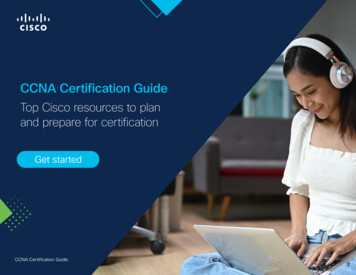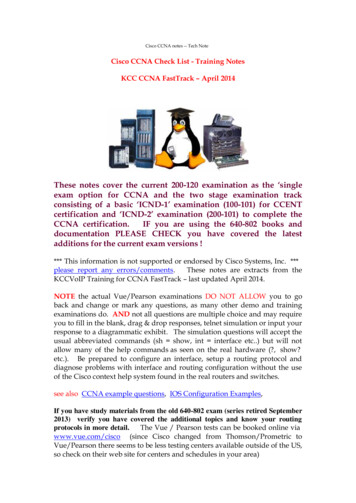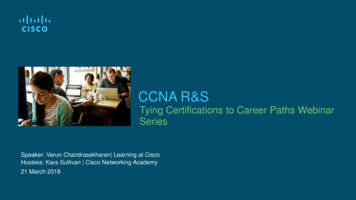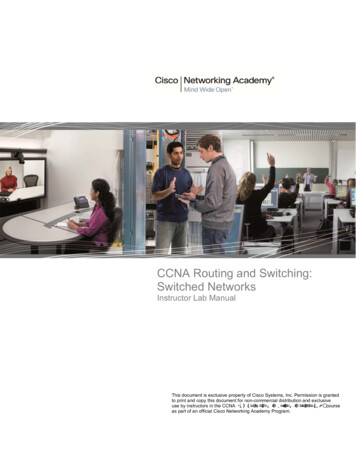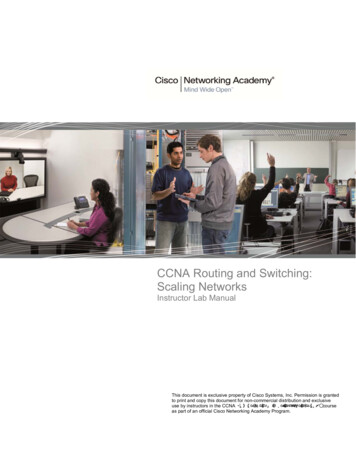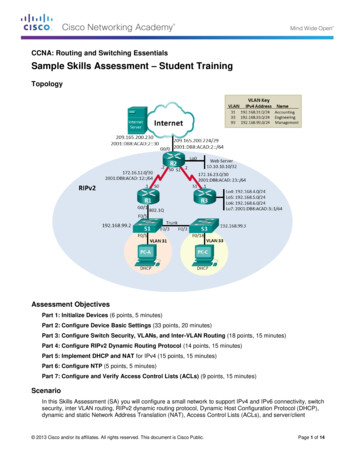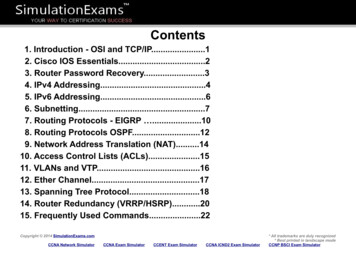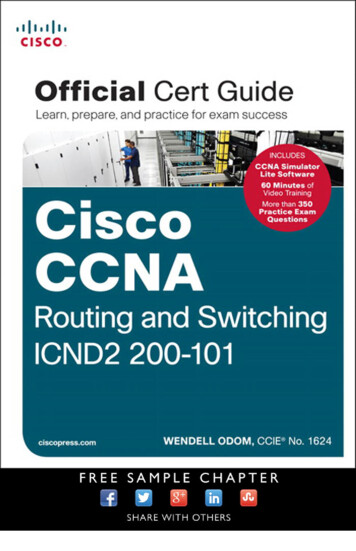
Transcription
CiscoCCNARouting and SwitchingICND2 200-101Official Cert GuideWENDELL ODOM, CCIE No. 1624Cisco Press800 East 96th StreetIndianapolis, IN 46240
iiCisco CCNA Routing and Switching ICND2 200-101 Official Cert GuideCisco CCNA Routing and SwitchingICND2 200-101 Official Cert GuideWendell Odom, CCIE No. 1624Copyright 2013 Pearson Education, Inc.Published by:Cisco Press800 East 96th StreetIndianapolis, IN 46240 USAAll rights reserved. No part of this book may be reproduced or transmitted in any form or by any means,electronic or mechanical, including photocopying, recording, or by any information storage and retrievalsystem, without written permission from the publisher, except for the inclusion of brief quotations in areview.Printed in the United States of AmericaFirst Printing April 2013Library of Congress Cataloging-in-Publication data is on file.ISBN-13: 978-1-58714-373-1ISBN-10: 1-58714-373-9Warning and DisclaimerThis book provides information about the Cisco 200-101 ICND2 and 200-120 CCNA exams. Every efforthas been made to make this book as complete and as accurate as possible, but no warranty or fitness isimplied.The information is provided on an “as is” basis. The authors, Cisco Press, and Cisco Systems, Inc. shallhave neither liability nor responsibility to any person or entity with respect to any loss or damages arisingfrom the information contained in this book or from the use of the discs or programs that may accompany it.The opinions expressed in this book belong to the author and are not necessarily those of Cisco Systems,Inc.Trademark AcknowledgmentsAll terms mentioned in this book that are known to be trademarks or service marks have been appropriately capitalized. Cisco Press or Cisco Systems, Inc., cannot attest to the accuracy of this information.Use of a term in this book should not be regarded as affecting the validity of any trademark or servicemark.
iiiCorporate and Government SalesThe publisher offers excellent discounts on this book when ordered in quantity for bulk purchases orspecial sales, which may include electronic versions and/or custom covers and content particular to yourbusiness, training goals, marketing focus, and branding interests.For more information, please contact:U.S. Corporate and Government or sales outside the United States, please contact:International Salesinternational@pearsoned.comFeedback InformationAt Cisco Press, our goal is to create in-depth technical books of the highest quality and value. Each bookis crafted with care and precision, undergoing rigorous development that involves the unique expertise ofmembers from the professional technical community.Readers’ feedback is a natural continuation of this process. If you have any comments regarding how wecould improve the quality of this book, or otherwise alter it to better suit your needs, you can contact usthrough email at feedback@ciscopress.com. Please make sure to include the book title and ISBN in yourmessage.We greatly appreciate your assistance.Publisher: Paul BogerCopy Editor: Keith ClineAssociate Publisher: Dave DusthimerTechnical Editor: Elan BeerBusiness Operation Manager, Cisco Press:Jan CornelssenEditorial Assistant: Vanessa EvansExecutive Editor: Brett BartowManaging Editor: Sandra SchroederDevelopment Editor: Andrew CuppSenior Project Editor: Tonya SimpsonCover Designer: Mark ShirarIllustrator: Michael TanamachiComposition: Bronkella PublishingIndexer: Erika MillenProofreader: Sarah Kearns
ivCisco CCNA Routing and Switching ICND2 200-101 Official Cert GuideAbout the AuthorWendell Odom, CCIE No. 1624, has been in the networking industry since 1981. He hasworked as a network engineer, consultant, systems engineer, instructor, and course developer; he currently works writing and creating certification tools. He is the author of allthe previous books in the Cisco Press CCNA Official Certification Guide series, as wellas author of the CCNP ROUTE 642-902 Official Certification Guide, the QoS 642-642Exam Certification Guide, and co-author of the CCIE Routing and Switch OfficialCertification Guide and several other titles. He is also a consultant for the CCNA640-802 Network Simulator from Pearson and for a forthcoming replacement versionof that product. He maintains study tools, links to his blogs, and other resources athttp://www.certskills.com.About the Contributing AuthorAnthony Sequeira, CCIE No. 15626, is a Cisco Certified Systems Instructor (CCSI) andauthor regarding all levels and tracks of Cisco certification. Anthony formally began hiscareer in the information technology industry in 1994 with IBM in Tampa, Florida. Hequickly formed his own computer consultancy, Computer Solutions, and then discoveredhis true passion: teaching and writing about Microsoft and Cisco technologies. Anthonyjoined Mastering Computers in 1996 and lectured to massive audiences around the worldabout the latest in computer technologies. Mastering Computers became the revolutionary online training company KnowledgeNet, and Anthony trained there for many years.Anthony is currently pursuing his second CCIE in the area of Security and is a full-timeinstructor for the next generation of KnowledgeNet, StormWind Live. Anthony is also aVMware Certified Professional.
vAbout the Technical ReviewerElan Beer, CCIE No. 1837, is a senior consultant and Cisco instructor specializing in datacenter architecture and multiprotocol network design. For the past 25 years, Elan hasdesigned networks and trained thousands of industry experts in data center architecture,routing, and switching. Elan has been instrumental in large-scale professional serviceefforts designing and troubleshooting internetworks, performing Data center and network audits, and assisting clients with their short- and long-term design objectives. Elanhas a global perspective of network architectures via his international clientele. Elan hasused his expertise to design and troubleshoot data centers and internetworks in Malaysia,North America, Europe, Australia, Africa, China, and the Middle East. Most recently,Elan has been focused on data center design, configuration, and troubleshooting as wellas service provider technologies. In 1993, Elan was among the first to obtain Cisco’sCertified System Instructor (CCSI) certification, and in 1996, he was among the first toattain Cisco System’s highest technical certification, the Cisco Certified InternetworkingExpert. Since then, Elan has been involved in numerous large-scale data center and telecommunications networking projects worldwide.
viCisco CCNA Routing and Switching ICND2 200-101 Official Cert GuideDedicationIn memory of Carcel Lanier (C.L.) Odom: Dad’s Pop, Poppa, wearing khakis, quiet, tearing down the old house (one board at a time), tagging along at the cow sales barn, walking the property, and napping during the Sunday morning sermon.
viiAcknowledgmentsAlthough published as a first edition for various reasons, this book (and the companionCisco CCENT/CCNA ICND1 100-101 Exam Cert Guide) represents the seventh bookin a long line of Cisco Press books focused on helping people pass the CCENT andCCNA R/S certifications. Given the long history, many people have worked on thesebooks from their inception back in 1998. To those many people who have touched thesebooks over these past 15 years—technical edits, development, copy edits, project editing,proofing, indexing, managing the production process, interior design, cover design, marketing, and all the other details that happen to get these books out the door—thanks somuch for playing a role in this CCENT/CCNA franchise.Many of the contributors to the previous editions returned to work on creating thesenew editions, including Development Editor Drew Cupp. Drew kept all the detailsstraight, with my frequent changes to the outlines and titles, keeping the sequencing ontrack, while still doing his primary job: keeping the text and features clear and consistentthroughout the book. Thanks, Drew, for walking me through the development.Contributing author Anthony Sequeira did a nice job stepping in on the network management part of the book. Anthony was a perfect fit, given his interest in management protocols and tools, and his writing experience and his great teaching skills (with enthusiasm!).Thanks for helping make this book complete and doing such a great job.As for technical editors, Elan Beer did his normal job. That is, he did his usual amazingjob of doing every part of the technical edit job well, from finding the tiny little crossreference errors that lie pages apart, to anticipating how readers might misunderstandcertain phrasing, to being all over the details of every technical feature. Fantastic job asusual; thanks, Elan.Brett Bartow again served as executive editor of the book, as he has almost since thebeginning of these titles. When my family has asked me over the years about Brett’s rolewith these books, the best single word definition is teammate. Brett may be employed atPearson Education, but he is always working with me and for me, watching out for thebusiness end of the books and finding ways to make the publisher/author relationshipwork seamlessly. Thanks for another great ride through these books, Brett!Word docs go in, and out come these beautiful finished products. Thanks to SandraSchroeder, Tonya Simpson, and all the production team for working through the magicthat takes those Word docs and makes the beautiful finished product. From fixing all mygrammar, crummy word choices, passive-voice sentences, and then pulling the design andlayout together, they do it all. Thanks for putting it all together and making it look easy.And Tonya, managing the details through several process steps for roughly 100 elementsbetween the pair of CCNA books in a short timeframe: Wow, thanks for the amazing juggling act! And thanks especially for the attention to detail.The figures for these books go through a little different process than they do for otherbooks. Together we invested a large amount of labor in updating the figures for thesebooks, both for the design, the number of figures, and for the color versions of the figures for the electronic versions of the books. A special thanks goes out to Laura Robbins
viii Cisco CCNA Routing and Switching ICND2 200-101 Official Cert Guidefor working with me on the color and design standards early in the process. Also, thanksto Mike Tanamachi for drawing all the figures so well (and then redrawing them everytime I changed my mind about something).Thanks to Chris Burns of CertSkills for all the work on the mind maps, both those usedin the final product and those used to build the book, as well as for being a bit of a testcase for some of the chapters.A special thank you to you readers who write in with suggestions, possible errors, andespecially those of you who post online at the Cisco Learning Network. Without question, the comments I receive directly and overhear by participating at CLN made this edition a better book.Thanks to my wife, Kris. Book schedules have a bigger impact than I would like, but youalways make it work. Thanks to my daughter, Hannah, for all the great study/work breakson some of these busy schooldays. And thanks to Jesus Christ, for this opportunity towrite.
ixContents at a GlanceIntroductionxxviiiGetting StartedPart I: LAN Switching311Chapter 1:Spanning Tree Protocol ConceptsChapter 2:Spanning Tree Protocol ImplementationChapter 3:Troubleshooting LAN SwitchingPart I Review134377124Part II: IP Version 4 Routing129Chapter 4:Troubleshooting IPv4 Routing Part I131Chapter 5:Troubleshooting IPv4 Routing Part II157Chapter 6:Creating Redundant First-Hop RoutersChapter 7:Virtual Private NetworksPart II Review205224Part III: IP Version 4 Routing Protocols229Chapter 8:Implementing OSPF for IPv4Chapter 9:Understanding EIGRP ConceptsChapter 10:Implementing EIGRP for IPv4Chapter 11:Troubleshooting IPv4 Routing ProtocolsPart III ReviewPart IV: Wide Area Networks231267291357Implementing Point-to-Point WANsChapter 13:Understanding Frame Relay ConceptsChapter 14:Implementing Frame RelayChapter 15:Identifying Other Types of WANsPart V: IP Version 6359409445464469Chapter 16:Troubleshooting IPv6 RoutingChapter 17:Implementing OSPF for IPv6499Chapter 18:Implementing EIGRP for IPv6529Part V Review323352Chapter 12:Part IV Review183550471389
x Cisco CCNA Routing and Switching ICND2 200-101 Official Cert GuidePart VI: Network Management555Chapter 19:Managing Network DevicesChapter 20:Managing IOS FilesChapter 21:Managing IOS LicensingPart VI ReviewPart VII: Final ReviewChapter 22:579605624627Final ReviewPart VIII: Appendixes629647Appendix A: Numeric Reference TablesAppendix B:557ICND2 Exam Updates649657Glossary 659Index 679DVD AppendixesAppendix CAnswers to the “Do I Know This Already?” QuizzesAppendix DMemory TablesAppendix EMemory Tables Answer KeyAppendix FMind Map SolutionsAppendix GStudy Planner
xiContentsIntroductionxxviiiGetting Started 3Part I: LAN SwitchingChapter 111Spanning Tree Protocol Concepts“Do I Know This Already?” QuizFoundation Topics131316LAN Switching Review16LAN Switch Forwarding LogicSwitch Verification1617Viewing the MAC Address Table17Determining the VLAN of a FrameVerifying Trunks1920Spanning Tree Protocol (IEEE 802.1D)The Need for Spanning Tree2122What IEEE 802.1D Spanning Tree DoesHow Spanning Tree Works25The STP Bridge ID and Hello BPDUElecting the Root Switch242727Choosing Each Switch’s Root Port29Choosing the Designated Port on Each LAN SegmentInfluencing and Changing the STP Topology3132Making Configuration Changes to Influence the STP TopologyReacting to State Changes That Affect the STP TopologyHow Switches React to Changes with STPChanging Interface States with STPOptional STP FeaturesEtherChannelPortFast363737BPDU Guard38Rapid STP (IEEE 802.1w)Exam Preparation TasksChapter 234353840Spanning Tree Protocol Implementation“Do I Know This Already?” QuizFoundation Topics4643433332
xiiCisco CCNA Routing and Switching ICND2 200-101 Official Cert GuideSTP Configuration and VerificationSetting the STP Mode4647Connecting STP Concepts to STP Configuration OptionsPer-VLAN Configuration Settings4747The Bridge ID and System ID Extension 48Per-VLAN Port Costs49STP Configuration Option SummaryVerifying STP Operation4950Configuring STP Port Costs53Configuring Priority to Influence the Root ElectionConfiguring PortFast and BPDU GuardConfiguring EtherChannel58Configuring a Manual EtherChannelConfiguring Dynamic EtherChannelsSTP Troubleshooting5556586061Determining the Root Switch62Determining the Root Port on Nonroot Switches63STP Tiebreakers When Choosing the Root Port64Suggestions for Attacking Root Port Problems on the ExamDetermining the Designated Port on Each LAN Segment6566Suggestions for Attacking Designated Port Problems on the ExamSTP Convergence68Troubleshooting EtherChannel68Incorrect Options on the channel-group Command68Configuration Checks Before Adding Interfaces to EtherChannelsExam Preparation Tasks73Command Reference to Check Your MemoryChapter 3Troubleshooting LAN Switching“Do I Know This Already?” QuizFoundation Topics73777778Generalized Troubleshooting Methodologies78Analyzing and Predicting Normal Network OperationData Plane Analysis7979Control Plane Analysis81Predicting Normal Operations: Summary of the ProcessProblem Isolation6782Root Cause Analysis83Real World Versus the Exams848170
xiiiTroubleshooting the LAN Switching Data Plane84An Overview of the Normal LAN Switch Forwarding ProcessStep 1: Confirm the Network Diagrams Using CDPStep 2: Isolate Interface Problems858688Interface Status Codes and Reasons for Nonworking StatesThe notconnect State and Cabling Pinouts90Determining Switch Interface Speed and DuplexIssues Related to Speed and Duplex889192Step 3: Isolate Filtering and Port Security ProblemsStep 4: Isolate VLAN and Trunking Problems9498Ensuring That the Right Access Interfaces Are in the Right VLANsAccess VLANs Not Being Defined or Not Being ActiveIdentify Trunks and VLANs Forwarded on Those TrunksTroubleshooting Examples and Exercises100102Troubleshooting Example 1: Find Existing LAN Data Plane ProblemsStep 1: Verify the Accuracy of the Diagram Using CDPStep 2: Check for Interface Problems107Step 4: Check for VLAN and VLAN Trunk Problems109Troubleshooting Example 2: Predicting LAN Data Plane BehaviorR1 ARP Reply (Unicast)Exam Preparation Tasks113116121Answers to Troubleshooting Example 1Part I ReviewChapter 4121124Part II: IP Version 4 Routing129Troubleshooting IPv4 Routing Part I“Do I Know This Already?” QuizFoundation Topics131131132Predicting Normal IPv4 Routing BehaviorHost IPv4 Routing Logic132132Routing Logic Used by IPv4 RoutersIP Routing Logic on a Single RouterIP Routing from Host to Host103104105Step 3: Check for Port Security ProblemsPC1 ARP Request (Broadcast)98100133134135Building New Data Link Headers Using ARP Information136112
xivCisco CCNA Routing and Switching ICND2 200-101 Official Cert GuideProblem Isolation Using the ping CommandPing Command Basics137138Strategies and Results When Testing with the ping Command139Testing Longer Routes from Near the Source of the ProblemUsing Extended Ping to Test the Reverse Route142Testing LAN Neighbors with Standard Ping144Testing LAN Neighbors with Extended Ping145Testing WAN Neighbors with Standard Ping145Using Ping with Names and with IP Addresses146Problem Isolation Using the traceroute Command147traceroute Basics147How the traceroute Command WorksStandard and Extended traceroute148150Using traceroute to Isolate the Problem to Two RoutersExam Preparation TasksChapter 5151154Troubleshooting IPv4 Routing Part II“Do I Know This Already?” QuizFoundation Topics139157157158Problems Between the Host and the Default Router158Root Causes Based on a Host’s IPv4 Settings 158Ensure IPv4 Settings Correctly Match 158Mismatched Masks Impact Route to Reach Subnet 160Typical Root Causes of DNS Problems161Wrong Default Router IP Address Setting 163Root Causes Based on the Default Router’s Configuration163Mismatched VLAN Trunking Configuration with Router on aStick 163DHCP Relay Issues166Router LAN Interface and LAN Issues167Problems with Routing Packets Between Routers169IP Forwarding by Matching the Most Specific Route170Using show ip route and Subnet Math to Find the Best RouteUsing show ip route address to Find the Best Routeshow ip route Reference172172Routing Problems Caused by Incorrect Addressing PlansRecognizing When VLSM Is Used or NotOverlaps When Not Using VLSM174174174170
xvOverlaps When Using VLSM176Configuring Overlapping VLSM SubnetsRouter WAN Interface Status178Filtering Packets with Access ListsExam Preparation TasksChapter 6178181Creating Redundant First-Hop Routers“Do I Know This Already?” QuizFoundation TopicsFHRP Concepts177183183186186The Need for Redundancy in Networks186The Need for a First Hop Redundancy Protocol188The Three Solutions for First-Hop RedundancyHSRP Concepts190HSRP Failover191HSRP Load BalancingGLBP Concepts192193FHRP Configuration and Verification195Configuring and Verifying HSRP195Configuring and Verifying GLBP198Exam Preparation Tasks202Command Reference to Check Your MemoryChapter 7Virtual Private Networks205“Do I Know This Already?” QuizFoundation Topics205207VPN FundamentalsIPsec VPNs202207209SSL VPNs211GRE Tunnels212GRE Tunnel Concepts212Routing over GRE Tunnels213GRE Tunnels over the Unsecured NetworkConfiguring GRE TunnelsVerifying a GRE TunnelExam Preparation Tasks214216218221Command Reference to Check Your Memory221189
xvi Cisco CCNA Routing and Switching ICND2 200-101 Official Cert GuidePart II Review224Part III: IP Version 4 Routing ProtocolsChapter 8229Implementing OSPF for IPv4231“Do I Know This Already?” QuizFoundation TopicsOSPF Protocols and OperationOSPF Overview231234234234Becoming Neighbors and Exchanging the LSDBAgreeing to Become Neighbors235236Fully Exchanging LSAs with NeighborsMaintaining Neighbors and the LSDB237238Using Designated Routers on Ethernet LinksScaling OSPF Using AreasOSPF Areas239240241How Areas Reduce SPF Calculation TimeOSPF Area Design AdvantagesLink-State Advertisements242243244Router LSAs Build Most of the Intra-Area TopologyNetwork LSAs Complete the Intra-Area TopologyLSAs in a Multi-Area Design245247Calculating the Best Routes with SPFAdministrative Distance245248250OSPF Configuration and VerificationOSPFv2 Configuration Overview251251Multi-Area OSPFv2 Configuration ExampleSingle-Area ConfigurationsMulti-Area Configuration252254255Verifying the Multi-Area Configuration256Verifying the Correct Areas on Each Interface on an ABRVerifying Which Router Is DR and BDR257Verifying the Number and Type of LSAs258Verifying OSPF RoutesOSPF Metrics (Cost)259259Setting the Cost Based on Interface BandwidthThe Need for a Higher Reference BandwidthOSPF Load Balancing262260261256
xviiExam Preparation Tasks263Command Reference to Check Your MemoryChapter 9Understanding EIGRP Concepts“Do I Know This Already?” QuizFoundation Topics264267267269EIGRP and Distance Vector Routing ProtocolsIntroduction to EIGRP269269Basic Distance Vector Routing Protocol FeaturesThe Concept of a Distance and a VectorFull Update Messages and Split HorizonRoute Poisoning271271273275EIGRP as an Advanced DV Protocol276EIGRP Sends Partial Update Messages, As NeededEIGRP Maintains Neighbor Status Using Hello276Summary of Interior Routing Protocol Features277EIGRP Concepts and OperationEIGRP Neighbors278278Exchanging EIGRP Topology Information279Calculating the Best Routes for the Routing TableThe EIGRP Metric CalculationCaveats with Bandwidth on Serial LinksEIGRP Convergence281283284Feasible Distance and Reported Distance284EIGRP Successors and Feasible SuccessorsThe Query and Reply ProcessExam Preparation Tasks285287288Implementing EIGRP for IPv4291“Do I Know This Already?” Quiz291Foundation Topics280280An Example of Calculated EIGRP MetricsChapter 10276294Core EIGRP Configuration and VerificationEIGRP Configuration294294Configuring EIGRP Using a Wildcard MaskVerifying EIGRP Core Features296296Finding the Interfaces on Which EIGRP is EnabledDisplaying EIGRP Neighbor StatusDisplaying the IPv4 Routing Table300301297
xviiiCisco CCNA Routing and Switching ICND2 200-101 Official Cert GuideEIGRP Metrics, Successors, and Feasible SuccessorsViewing the EIGRP Topology TableFinding Successor Routes302303305Finding Feasible Successor Routes306Convergence Using the Feasible Successor RouteExamining the Metric ComponentsOther EIGRP Configuration Settings308310311Load Balancing Across Multiple EIGRP RoutesTuning the EIGRP Metric Calculation311313Autosummarization and Discontiguous Classful Networks314Automatic Summarization at the Boundary of a Classful NetworkDiscontiguous Classful NetworksExam Preparation TasksChapter 11315318Command Reference to Check Your Memory318Troubleshooting IPv4 Routing Protocols323“Do I Know This Already?” QuizFoundation Topics323324Perspectives on Troubleshooting Routing Protocol ProblemsInterfaces Enabled with a Routing ProtocolEIGRP Interface Troubleshooting325327Examining Working EIGRP Interfaces 327Examining the Problems with EIGRP Interfaces 330OSPF Interface TroubleshootingNeighbor Relationships332335EIGRP Neighbor Verification Checks337EIGRP Neighbor Troubleshooting ExampleOSPF Neighbor TroubleshootingFinding Area Mismatches338339341Finding Duplicate OSPF Router IDs342Finding OSPF Hello and Dead Timer MismatchesOther OSPF Issues345Mismatched OSPF Network TypesMismatched MTU SettingsExam Preparation Tasks345346348Command Reference to Check Your Memory348343324314
xixPart III Review352Part IV: Wide-Area Networks 357Chapter 12Implementing Point-to-Point WANs“Do I Know This Already?” QuizFoundation Topics359359362Leased Line WANs with HDLCLayer 1 Leased Lines362363The Physical Components of a Leased LineLeased Lines and the T-Carrier SystemThe Role of the CSU/DSU367Building a WAN Link in a Lab367Layer 2 Leased Lines with HDLCConfiguring HDLC363365368370Leased-Line WANs with PPPPPP Concepts373PPP Framing374PPP Control Protocols373374PPP Authentication 375Configuring PPP376CHAP Configuration and VerificationTroubleshooting Serial Links377378Troubleshooting Layer 1 Problems379Troubleshooting Layer 2 Problems380Keepalive Failure381PAP and CHAP Authentication FailureTroubleshooting Layer 3 ProblemsExam Preparation Tasks382383386Command Reference to Check Your MemoryChapter 13Understanding Frame Relay Concepts“Do I Know This Already?” QuizFoundation Topics389389392Frame Relay OverviewVirtual Circuits386392394LMI and Encapsulation Types396Frame Relay Encapsulation and Framing397
xx Cisco CCNA Routing and Switching ICND2 200-101 Official Cert GuideFrame Relay Addressing398Frame Relay Local Addressing398Frame Forwarding with One DLCI Field399Network Layer Addressing with Frame Relay401Frame Relay Layer 3 Addressing: One Subnet Containing All Frame RelayDTEs 401Frame Relay Layer 3 Addressing: One Subnet Per VCFrame Relay Layer 3 Addressing: Hybrid ApproachExam Preparation TasksChapter 14404406Implementing Frame Relay409“Do I Know This Already?” QuizFoundation Topics402409412Frame Relay Configuration and VerificationPlanning a Frame Relay Configuration412412Configuring Using Physical Interfaces and One IP SubnetConfiguring the Encapsulation and LMIFrame Relay Address Mapping413415416Configuring Point-to-Point Subinterfaces421Configuring with Multipoint Subinterfaces426OSPF Issues on Frame Relay Multipoint and Physical InterfacesFrame Relay Troubleshooting430A Suggested Frame Relay Troubleshooting ProcessLayer 1 Issues on the Access Link (Step 1)432Layer 2 Issues on the Access Link (Step 2)432PVC Problems and Status (Step 3)433Frame Relay Mapping Issues (Step 4)End-to-End Encapsulation (Step 5)440441Mismatched Subnet Numbers (Step 6)Exam Preparation Tasks441442Command Reference to Check Your MemoryChapter 15Identifying Other Types of WANs“Do I Know This Already?” QuizFoundation Topics445447Private WANs to Connect EnterprisesLeased Lines447Frame Relay449Ethernet WANs445449447442430429
xxiMPLS451VSAT452Public WANs and Internet Access453Internet Access (WAN) Links453Dial Access with Modems and ISDNDigital Subscriber LineCable Internet456457Mobile Phone Access with 3G/4GPPP over Ethernet463464Part V: IP Version 6Chapter 16459460Exam Preparation TasksPart IV Review454469Troubleshooting IPv6 Routing471“Do I Know This Already?” Quiz471Foundation Topics472Normal IPv6 Operation472Unicast IPv6 Addresses and IPv6 SubnettingAssigning Addresses to HostsStateful DHCPv6472475475Stateless Address Autoconfiguration476Router Address and Static Route Configuration477Configuring IPv6 Routing and Addresses on RoutersIPv6 Static Routes on RoutersVerifying IPv6 Connectivity477478479Verifying Connectivity from IPv6 Hosts479Verifying IPv6 from Routers 481Troubleshooting IPv6483Pings from the Host Work Only in Some CasesPings Fail from a Host to Its Default Router484486Problems Using Any Function That Requires DNS487Host Is Missing IPv6 Settings: Stateful DHCP IssuesHost Is Missing IPv6 Settings: SLAAC IssuesTraceroute Shows Some Hops, But Fails489490Routing Looks Good, But Traceroute Still FailsExam Preparation Tasks494Command Reference to Check Your Memory495492488
xxii Cisco CCNA Routing and Switching ICND2 200-101 Official Cert GuideChapter 17Implementing OSPF for IPv6499“Do I Know This Already?” QuizFoundation Topics499502OSPFv3 Configuration502OSPFv3 ICND1 Configuration Review 502Example Multi-Area OSPFv3 Configuration 503Single Area Configuration on the Three Internal Routers504Adding Multi-Area Configuration on the Area Border RouterOther OSPFv3 Configuration Settings507Setting OSPFv3 Interface Cost to Influence Route SelectionOSPF Load Balancing 508Injecting Default Routes 508OSPF Concepts, Verification, and TroubleshootingOSPFv3 Interfaces509511Verifying OSPFv3 Interfaces511Troubleshooting OSPFv3 Interfaces512OSPFv3 Neighbors 513Verifying OSPFv3 Neighbors513Troubleshooting OSPFv3 Neighbors514OSPFv3 LSDB and LSAs 517Verifying OSPFv3 LSAs517Troubleshooting OSPFv3 LSAs519OSPFv3 Metrics and IPv6 Routes 520Verifying OSPFv3 Interface Cost and Metrics520Troubleshooting IPv6 Routes Added by OSPFv3Exam Preparation Tasks523525Command Reference to Check Your MemoryChapter 18525Implementing EIGRP for IPv6 529“Do I Know This Already?” Quiz 529Foundation Topics532EIGRPv6 Configuration532EIGRPv6 Configuration Basics532EIGRPv6 Configuration Example533Other EIGRPv6 Configuration Settings536Setting Bandwidth and Delay to Influence EIGRPv6 RouteSelection 536EIGRP Load Balancing 537EIGRP Timers 538506507
xxiiiEIGRPv6 Concepts, Verification, and TroubleshootingEIGRPv6 Interfaces539EIGRPv6 Neighbors541EIGRPv6 Topology DatabaseEIGRPv6 IPv6 RoutesExam Preparation Tasks543545547Command Reference to Check Your Memory547Part V Review 550Part VI: Network ManagementChapter 19555Managing Network Devices557“Do I Know This Already?” QuizFoundation Topics557560Simple Network Management ProtocolDescribing SNMPThe Management Information BaseConfiguring SNMP Version 2cSNMP Version 3560560562563565System Message Logging (Syslog) 566An Overview of System Message LoggingSystem Message Format567System Message Severity Levels567Configuring and Verifying SyslogUsing a Syslog ServerNetFlow569570An Overview of NetFlowNetwork Flows570571Configuring NetFlow572Verifying and Using NetFlowThe NetFlow CollectorExam Preparation TasksChapter 20568Managing IOS Files575576579“Do I Know This Already?” QuizFoundation Topics573581579566538
xxivCisco CCNA Routing and Switching ICND2 200-101 Official Cert GuideManaging Cisco IOS Files581Upgrading a Cisco IOS Software Image into Flash MemoryThe Cisco IOS Software Boot SequenceThe Three Router Operating SystemsThe Configuration Register581584585586How a Router Chooses Which OS to LoadRecovering If the IOS Does Not Load586588Verifying the IOS Image Using the show vers
iv Cisco CCNA Routing and Switching ICND2 200-101 Official Cert Guide About the Author Wendell Odom, CCIE No. 1624, has been in the networking industry since 1981. He has worked as a network engineer, consultant, systems engineer, instructor, and course devel-oper; he currently works writing and creating


